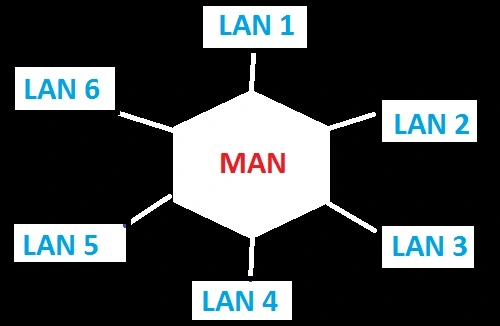A MAN, or Metropolitan Area Network, is a computer network that serves the purpose of connecting different Local Area Networks (LANs) spread across a vast geographic area, usually the city or a group of neighboring cities. That’s just the definition of it in the simplest words possible right there. It is an intermediary kind of network, being larger than a LAN and smaller than a Wide Area Network (WAN). MANs are generally used to connect different buildings or campuses by providing high-speed data transfer and helping with even faster communication. Let’s know the pros and cons of MAN network:

Advantages of Metropolitan Area Networks (MAN)
1. Say Goodbye to Buffering
One of the biggest advantages of a Metropolitan Area Network (MAN) is its high bandwidth capacity, which is basically the main reason why this type of network system is used in the first place. This means that it can hold a bulk of data at once enabling the transmission of information in a faster and more efficient manner, you know? That’s not it though, in the case of a MAN, as it utilizes fiber optic cables, the speed is usually much higher, typically up to 1000 Mbps.
2. Cost-Effective Networking
Specifically in the comparison of other types of networking with MANs: like a Wide Area Network (WAN), a MAN is generally the most cost-effective means of covering a city or a wider area. It connects smaller networks called Local Area Networks (LANs) that no longer require long-distance connections like each LAN if used to be the case. So yes, the costs of data transfer and updates for tracking are also less as they are centrally controlled, which is a much more efficient process.
3. Scalability That Keeps Pace with Your Needs
See, as a business or institution, they get more users meaning that there will be more data transfer and that will be the time to get more connections. A MAN is a network that can grow if it needs to be rather than being replaced with a new one thus it can be a future-proof option that will expand with the organization and however or whenever they want. That’s one of the best bits.
4. Boosting Collaboration Across Town
What do we mean by this one? How is it good for collaborations? Well, for example, the information from a university that has district campuses can be easily shared or transferred via a MAN in order to connect all of its buildings, such as in the case of transcript files, applications, or printers. As a result, the connectivity not only improves the processes but also multiplies the productivity and the overall harmony of the team at work.
5. Robust Security Measures In Place
Without a doubt, security is one of the utmost concerns and priorities of any networking system out there. And as you have guessed, in this regard, MANs are pretty great because there are many security measures in place. For example, by encrypting the information, even if the receiver intercepts it and reads it, they cannot break through it without the proper key.
6. Seamless Transition from LAN to MAN
It is generally easy to convert from a Local Area Network (LAN), which you are already using, to a MAN. This is particularly seen when the LANs run on fiber optics, which is a very popular technology that helps achieve MAN architecture. So yes, you don’t need to start from scratch, you can very easily modify your old LAN into a MAN. That’s it.
Disadvantages of Metropolitan Area Networks (MAN)
1. High Upfront Costs
Even though in the long run a Metropolitan Area Network (MAN) can be more cost-effective, a MAN’s initial setup is quite costly. Fiber-optic cables and other telecommunication equipment that are necessary for the transference of high-speed data which MANs are known for are the top costs. So yes, it is kinda costly.
2. Dealing with Technical Complexities
To install and maintain a MAN is not only a matter of connecting a few wires but rather an art that requires in-depth knowledge of networking technologies, you know? So yes, therefore, you will need a technical human resource that is proficient in the installation, maintenance, and troubleshooting of the network to do the task. And that’s another cost right there.
3. Potential Security Weak Spots
See, even if MANs have proven to be robust and safe, they are still large and more complicated than smaller networks like LANs which makes them quite vulnerable to hackers. And yes, a successful attack on a MAN, as opposed to a personal computer, can affect a wide range of users thus, keeping the system safe is a constant worry. So, the piece of mind is missing.
4. There Are Geographical Restrictions
Another thing is that there are some geographical barriers or restrictions when it comes to this type of network system. Like what exactly? Well, for example, if the users or the offices are outside the city limits or are in a different region, they cannot connect to the MAN directly. To cover additional areas a proper service network will, however, be needed.
5. Reliability Concerns
Of course, just like any network, MANs can get issues that can affect their reliability. Such hardware failures, power outages, or even infrastructure issues can cause this. These issues for sure can cause the whole network to collapse and critical business operations to be interrupted.
6. Increased Risk of Cyber Attacks
Since they combine several LANs into one, MANs could create more opportunities for cyber-attacks than just a single LAN would do, you know? Hackers could see breaking into MAN as an easier target compared to a small LAN because of its size and the number of devices connected to it. And that’ll again require extra layers of security, which aren’t cheap.
Comparison Table for Advantages and Disadvantages of MAN Network
| Advantages | Disadvantages |
| Superfast data speeds, no more annoying buffering! | Setting up can be pricey |
| Cheaper than WANs for city coverage. | Requires techy folks to handle the complex setup and maintenance |
| Easily scalable as your needs expand | Bigger network means more tempting for hackers |
| Connects offices across town for easy collaboration | Won’t work if you’re outside the metro area |
| Strong built-in security features to keep your data safe | Technical issues can cause downtime |
| Build on what you’ve got without starting from scratch | More entry points mean more places for cyber attacks |

